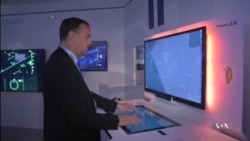Thanks to the seemingly unstoppable advance of electronic and mechanical devices, aircraft manufacturers are constantly upgrading the cockpit environment and the passenger cabin, making flying the plane and traveling in it easier, and more pleasurable. Some of these innovations were on display at the recent International Air Show in Paris.
Aircraft cockpits have changed considerably over the past half century. The yoke-shaped control columns were replaced with joysticks, first developed for computer games.
Analog clock-like instruments have given way to electronic displays with touch-sensitive screens.
Honeywell Aerospace Vice President Ken Snodgrass said his company is testing its advanced cockpit in a small passenger jet.
“It has four very large screens, and you'll see things are set up to be very, very graphical. So, not like the older cockpits where you had a lot of button pushes. There's a lot more now like you use on your mobile phone and also for your tablets,” said Snodgrass.
Visually simplified information, displayed on small screens in front of a pilot’s eye, will enable pilots to quickly grasp a situation and make the best possible decisions, said Thales Avionics Marketing Director Richard Perrot.
“This system is based on our [more than] 20 years of experience within the military field on helmet-mounted display systems, and for the first time we will introduce it on commercial aircraft,” said Perrot.
Thales’ senior development engineer Sylvain Moos said similar changes are coming to air traffic control centers.
“We have no keyboard, no mouse. The controller is interacting with the system through the gaze information [eye tracking technology] and the touchscreen,” said Moos.
Manufacturers are not forgetting the passengers. Video displays in the back of passenger seats will offer real-time connectivity and much more entertainment than today.
Senior manager for Panasonic Avionics, Matthias Walther, said the goal is to make the passenger feel almost at home.
“What we're close to really delivering is the seamless travel process for the passenger. So there's no difference between the experience that you have on the ground and the experience you have on the aircraft,” he said.
Exhibitors at the Paris Air Show say that by 2020, cockpits in most passenger aircraft will have advanced touch-sensitive screens, while pilots will wear head-mounted displays.









